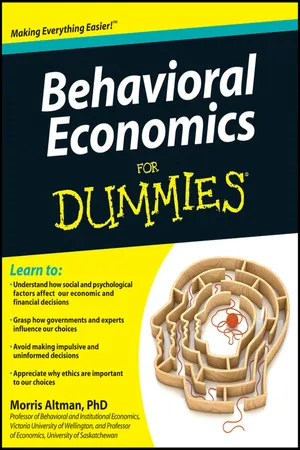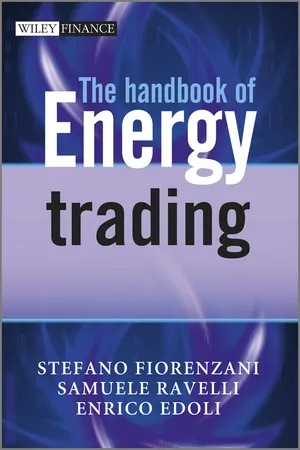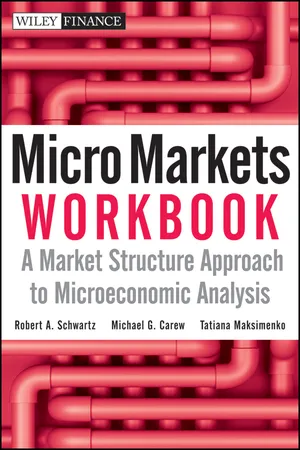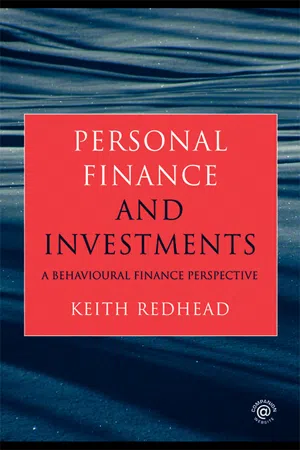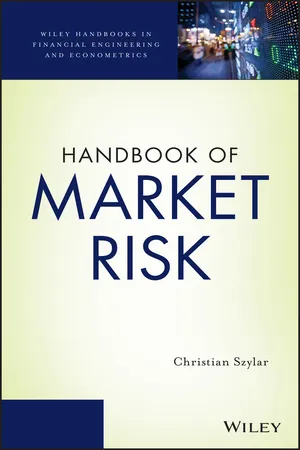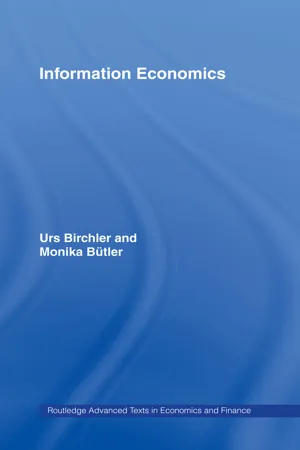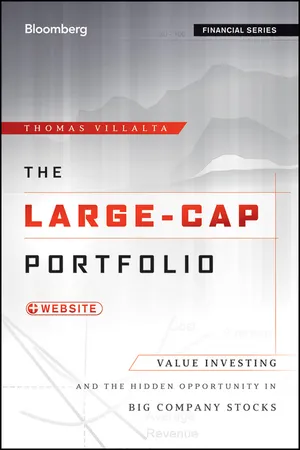Economics
Market Inefficiency
Market inefficiency refers to a situation where the price of an asset does not accurately reflect all available information. This can lead to mispricing and opportunities for investors to profit from the market's failure to incorporate all relevant data. Market inefficiency is a key concept in the study of financial economics and can be exploited through various trading strategies.
Written by Perlego with AI-assistance
Related key terms
10 Key excerpts on "Market Inefficiency"
- eBook - ePub
Understanding Investments
Theories and Strategies
- Nikiforos T. Laopodis(Author)
- 2020(Publication Date)
- Routledge(Publisher)
For example, the securities of high-risk industries will command higher prices (returns) in anticipation of higher profits and securities of lower-risk industries will command lower expected rates of return. Thus, investors in such an economy expect to pay and receive fair prices for their traded assets. So in order to understand that, we must first explain what is meant by market efficiency. This is the main task of this chapter. Once we define it, we shall then trace the implications of market efficiency with respect to some of the investment strategies we have learned so far and then present some empirical evidence on market efficiency. The second part of this chapter deals with the relatively new field of behavioral finance. We first mentioned this term in Chapter 2, but here we will take a more detailed look into its tenets and implications for investment decisions. 9.2 The efficient market hypothesis 9.2.1 The notion of market efficiency We said above that investors who possesses and use the same information cannot make abnormal profits indefinitely in an informationally efficient market. That is because if all investors purchased the stock, its price would immediately be bid up to the level where no one would want it anymore! In other words, the stock’s price would jump to its fair price, given all available information. This situation best describes an efficient market, in which all assets are fairly priced at all times with no opportunities for excess returns (or profits). But, what if stock prices were indeed predictable? That would be first-class evidence of Market Inefficiency! Stated differently, if prices could be predicted then this would mean that the already available information was not effectively and fully incorporated into these current prices - eBook - ePub
Investments
Principles of Portfolio and Equity Analysis
- Michael McMillan, Jerald E. Pinto, Wendy L. Pirie, Gerhard Van de Venter(Authors)
- 2011(Publication Date)
- Wiley(Publisher)
The use of behavioral theories to explain observed pricing is an important part of the understanding of how markets function and how prices are determined. Whether there is a behavioral explanation for market anomalies remains a debate. Pricing anomalies are continually being uncovered, and then statistical and behavioral explanations are offered to explain these anomalies.On the one hand, if investors must be rational for efficient markets to exist, then all the foibles of human investors suggest that markets cannot be efficient. On the other hand, if all that is required for markets to be efficient is that investors cannot consistently beat the market on a risk-adjusted basis, then the evidence does support market efficiency.6. SUMMARYThis chapter has provided an overview of the theory and evidence regarding market efficiency and has discussed the different forms of market efficiency as well as the implications for fundamental analysis, technical analysis, and portfolio management. The general conclusion drawn from the efficient market hypothesis is that it is not possible to beat the market on a consistent basis by generating returns in excess of those expected for the level of risk of the investment.Additional key points include the following:- The efficiency of a market is affected by the number of market participants and depth of analyst coverage, information availability, and limits to trading.
- There are three forms of efficient markets, each based on what is considered to be the information used in determining asset prices. In the weak form, asset prices fully reflect all market data, which refers to all past price and trading volume information. In the semistrong form, asset prices reflect all publicly known and available information. In the strong form, asset prices fully reflect all information, which includes both public and private information.
- Intrinsic value refers to the true value of an asset, whereas market value refers to the price at which an asset can be bought or sold. When markets are efficient, the two should be the same or very close. But when markets are not efficient, the two can diverge significantly.
- eBook - ePub
- Morris Altman(Author)
- 2012(Publication Date)
- For Dummies(Publisher)
Behavioral finance tries to understand why asset prices usually deviate from their fundamental or intrinsic values. These deviations are considered to represent inefficient pricing of financial assets. The benchmark for efficient pricing is the fundamental or intrinsic value of what the financial asset represents in the real world.If the intrinsic value of an asset, based on the real economy is 10¢, the total number of shares for this asset shouldn’t be selling for $10 or even $1. Likewise, if the intrinsic value of an asset is $10, the total number of shares shouldn’t be selling for 10¢.If there is a difference between the market price of an asset and its fundamental or intrinsic value, then, according to conventional wisdom, no one — no matter how smart or well endowed with resources — can make money in financial markets by exploiting the difference. Exploiting this difference for profit would require being able to consistently predict movements in asset prices. It amounts to an individual knowing more than the market knows about what asset prices will be. For some people, this amounts to gazing into a crystal ball — a dream, but an impossible dream, even for the world’s leading brokerage houses.More often than not, efficient markets are assumed to consist of two key components:Efficient market hypothesis: This is the idea that asset prices and fundamental values are one and the same — or at least the two converge so quickly that differences aren’t important for an understanding of real-world financial markets.Random walk hypothesis: - eBook - ePub
- Stefano Fiorenzani, Samuele Ravelli, Enrico Edoli(Authors)
- 2011(Publication Date)
- Wiley(Publisher)
The efficient market hypothesis has aroused interest in the public debate not because of its theoretical appeal, but mainly for its trading implications. In fact, if the disclosure of a certain information set to market participants does not affect their price forecast, no extra profits can be extracted on the basis of that information set. In the weak-form efficiency case the information set is basically the complete knowledge of price history. This implies that if a market is efficient in weak form, trading based on technical or statistical analysis cannot provide expected excess returns, while fundamental trading can still be profitable. In a semi-strong efficient market not even fundamental trading can be expected to overshoot the market, while the strong efficiency form is that theoretical situation in which not even with private information can we expect consistently to realize extra returns. Obviously, the last situation is a purely theoretical one since if a strongly efficient market were to exist, trading would be meaningless in it (as also a book on trading!).Looking at how many people work in the trading industry around the world we might well be inclined to say that, in general, financial markets are far from being efficient. But, what is a market in practice? Is it possible that a market can be considered efficient for a certain asset class and not for another? It can happen that information fully reflected into a certain security's price (and hence irrelevant for its better prediction) can be useful to better predict the future price of an other security. It can be that (especially in those markets characterized by a mix of financial and industrial investors) market segmentation allows for an inefficient mechanism of transmission of information and consequently potential excess profits.A full understanding of the degree of efficiency of the market we are operating in, conditional on the information set we are endowed with, allows us to understand which trading activity is worth setting up and what is the best way of allocating our risk capital. It is interesting to analyze in depth and specify the concept of market efficiency within different market sectors in order to verify the concrete possibility of making money out of our energy trading activity.1.1.2 Informational and Mathematical ImplicationsSo far we have defined and analyzed the EMH as an information-based concept. In practice, a market is considered efficient if it is able to reflect the information flow immediately into asset price dynamics. However, we have not really formally defined the concept of information. We said that a market framework is efficient at time t with respect to a certain information set φ(t ) if revealing that information to market players will not change their future price forecast. This implies, obviously, that market players are already endowed with an information set Φ(t ) already containing φ(t ) [formally, ]. If we imagine that agents formulate their future price forecast by means of the conditional expectation operator, we may write the following expression using the Law of Iterated Expectations - eBook - ePub
Micro Markets Workbook
A Market Structure Approach to Microeconomic Analysis
- Robert A. Schwartz, Michael G. Carew, Tatiana Maksimenko(Authors)
- 2010(Publication Date)
- Wiley(Publisher)
CHAPTER 7Market EfficiencyLEARNING OBJECTIVES
• Understand the concept of allocation efficiency. Given that economics can be defined as “the study of the optimal allocation of scarce resources among competing needs,” you should not be surprised that the efficiency of resource allocation is of fundamental importance. This chapter focuses on the ability of a market to achieve allocation efficiency (goods and services being produced in the right ways and amounts and consumed in the right amounts from a public policy point of view).• Comprehend the meaning of the term market failure. It is important to recognize that a micro market can fail to deliver the allocation efficiency that one might desire from a public policy point of view (and that in extreme cases, a micro market may even fail to exist). Chapter 7 enumerates 10 classic causes of market failure.• Understand the link between information and expectations. In an environment characterized by risk and uncertainty, information is the input that participants base their expectations on. Different participants may form identical expectations (referred to as homogeneous expectations) or have different expectations (referred to as divergent expectations). You should recognize the complexity of information, and be aware that our insights into the workings of a financial market are influenced by whether we assume that participants’ expectations are homogeneous, or that they are divergent.• Acquire some basic information about information. A sizable part of this chapter focuses on information that you should see as a driving force for the micro markets. In light of its importance, we consider information a factor of production. The chapter states that “information sets themselves can be enormous, incomplete, imprecise, and inaccurate, and inefficiency in the micro markets can, to no inconsequential extent, be attributed to information-related inefficiencies.” An important learning objective is to understand what this entails in greater detail. - eBook - ePub
Personal Finance and Investments
A Behavioural Finance Perspective
- Keith Redhead(Author)
- 2008(Publication Date)
- Routledge(Publisher)
Market EfficiencyPassage contains an image
Chapter 23Market efficiency: Concepts and weak form evidence
The objective of this chapter is to provide knowledge of:OBJECTIVE- The concepts of weak, semi-strong, and strong form informational efficiency.
- Evidence of arbitrage failures.
- Empirical evidence on the weak form of the efficient market hypothesis.
- Evidence on overshooting and mean reversion.
- Evidence on momentum and contrarian strategies.
- The implications of market efficiency for investment analysis.
TYPES OF EFFICIENCY
Market efficiency can be divided into three types: allocative efficiency, operational efficiency, and informational efficiency. Allocative efficiency is concerned with whether funds are directed to their most productive uses. This is mainly a primary market issue; the primary market being the market in which borrowers issue securities and receive payment from the initial investors (the word ‘borrowers’ here includes companies that raise money by issuing shares although, strictly speaking, share issuance is not borrowing). Allocative efficiency is concerned with the issue of which borrowers receive the finance. An allocatively efficient market is one in which the available funds go to the borrowers who will make the most productive use of them. Allocative efficiency is not the main concern here. However, it is important to be aware that allocative efficiency is dependent on operational and informational efficiency.Allocative efficiency is dependent upon securities (shares and bonds) being accurately priced. Accurate pricing requires informational efficiency. If securities are not accurately priced, investors could direct their money to uses that are not the most productive. For example during 1999 and early 2000 shares in Internet-related companies were seriously overpriced. For those people establishing Internet-related companies, the proceeds from share sales heavily exceeded the costs of establishing the companies. So there was a great incentive to set up Internet-related companies. Too many Internet-related companies were created and most of them subsequently failed. The overpricing of shares issued by Internet-related companies had caused too much money to be invested in such companies. Much of this money could have been invested more productively elsewhere. - eBook - ePub
- Christian Szylar(Author)
- 2013(Publication Date)
- Wiley(Publisher)
hapter TwoThe Efficient Markets TheoryI'd be a bum on the streets with a tin cup if the markets were efficient.—Warren BuffettIn this chapter we will examine a fundamental question about financial markets. This question has raised a lot of debates among practitioners and academics about its reality. The question is about market efficiency, along with the following questions: How do financial markets match providers with users and, more importantly, how efficiently does the market determine prices?The financial markets perform much the same function as the markets for other goods and services. They bring large numbers of buyers and sellers together, thus relieving each party of the need for a potentially long and expensive search for a counterpart with exactly equal but opposite needs to his or her own. The existence of such a market improves price transparency, encourages competition, and improves efficiency generally.But the financial markets can also be highly volatile. The stock market is possibly the most volatile of them all. Some investors will win and some will lose. Is it just a matter of luck or skill? Or does it depend on a mixture of the two?A fair return on investment is one that offers the investor just the right level of compensation for the expected risk of the investment (in addition to the time preference rate and an adjustment for expected inflation). But why is it so important at the end whether market prices for investments in fact offer fair returns? Could we argue that the pricing of investments is a zero-sum game in which one investor's loss is another's gain? For every investor who loses by buying at the top of the market and selling at the bottom, there must be another who profits by doing the opposite. So we can argue that if a particular investment offers either an excessive or an inadequate return, total income and wealth are neither increased nor reduced but simply redistributed among the market participants. - eBook - ePub
- Urs Birchler, Monika Bütler(Authors)
- 1999(Publication Date)
- Routledge(Publisher)
37In our example of Alice running for club presidency and Bob hoping for promotion, prices were not fully revealing. They did express the information Alice and Bob were primarily interested in (their individual chances), but they did not reveal the precise pieces of information that had gone into them.... and in the sense of empirical research
In empirical finance literature, informational efficiency is defined somewhat differently as the absence of profit opportunities. The Efficient Market Hypothesis rests on three assumptions (Fama, 1970): (i) No transaction costs, (ii) information is available without cost, and (iii) rational expectations (agreement on the same model generating future returns).There are three levels of efficiency commonly distinguished in the literature:- Strong form : Prices reflect all public and private information in the sense that it does not leave any profitable trading opportunity, even for "insiders".
- Semi-strong form : Prices reflect all public information, thus leaving profit opportunities to parties with private information.
- Weak form : Prices fully reflect the history of past prices. There is thus no profitable trading opportunity based on past prices, or as the saying goes "markets have no memory". Yet, traders may make profits from fundamental research and private information.
7 C d Some paradoxes
The Information Paradox (Grossman—Stiglitz)
The Efficient Market Hypothesis has an important implication, the so-called Information Paradox. - eBook - ePub
Public Economics
A Concise Introduction
- José Luis Gómez-Barroso(Author)
- 2021(Publication Date)
- Routledge(Publisher)
Can all these requisites be met simultaneously? The answer is no. This means that the market cannot guarantee the results that the welfare theorems predict. Or, put another way, in practice, the price system is not a Pareto-efficient mechanism for allocating resources, nor can it ensure that its results are equitable to any degree.The following sections examine the reasons behind this statement. As mentioned in the introduction, these market failures are divided into failures of the market and of specific markets. In addition, other reasons for public activity have nothing to do with efficiency.3 Reasons related to efficiency in the market: failures of the marketIn any economy, the market is composed of the sum of the individual markets of the different goods and services that are exchanged in that economy. As a consequence, everything that occurs in the market originates in those specific markets. That said, the image of the market as a whole provides arguments to evaluate the efficiency of the market (now understood as a form of organizing economic activity) that are different from the arguments that can be found in specific markets.Furthermore, not only are these arguments conceptually different, but they are different in scope. The presence of failures in some specific markets would seem at first to justify action only in those markets. But given that some actions (economic policies) deal with the economy as a whole, as we shall see in Chapter 4 , the reasons for those policies should be based on the situation of the economy as a whole. These are the reasons that will be studied in this section and the next.The first subset of arguments refers to the efficiency of the market. The first two arguments that will be presented next clearly fit in this section. The last two also deal with efficiency but introduce the time factor, which is not considered in the theorems of welfare economics. In fact, the actors in a market at a specific moment in time do not have to be interested in anything other than immediate outcomes. Even so, examining these two additional reasons in the section dealing with causes that are tied to efficiency seems more appropriate than dealing with them in the next, which examines causes that are unrelated to efficiency. - eBook - ePub
The Large-Cap Portfolio
Value Investing and the Hidden Opportunity in Big Company Stocks
- Thomas Villalta(Author)
- 2012(Publication Date)
- Bloomberg Press(Publisher)
Be mindful of the symbiotic relationship between portfolio management and client service . In my experience, there’s often a contentious relationship between the client-servicing branch in professional money management firms and the portfolio management and analysis functions. This is truly a self-defeating, misalignment of interests. Part of investment management is not only having the patience to make one’s way through the “interim” period discussed previously, but also having a clientele that understands that the behavioral factors that make certain stocks cheap can make them even cheaper. We cannot pick bottoms for stocks. All we can do is find undervalued securities and have the patience to hold them until prices move toward intrinsic values. Having an effective client service function that is able to explain a strategy and keep investors patient is paramount to this process.This chapter concludes a critique of the three theories that underpin the notion of market efficiency. While there are those who would argue that markets are efficient, others argue that markets are inefficient—both groups are off the mark. In short, they’re not really asking the right question. The right question might be: where on the spectrum of market efficiency do you fall? Empirical evidence seems to suggest that the right questions relates to the time frame rather than a definitive question of whether efficiency exists. In this sense, it is likely that the market is both efficient and inefficient, depending on one’s perspective of the time it takes for prices to move to accurate reflections of value.To this end, it may be easier to consider the issue of market efficiency as a spectrum of time horizons, as seen in Figure 6.3 .FIGURE 6.3 Spectrum of Time from Instantaneous to Long TermOn one end of the spectrum we have instantaneous reflection of accurate intrinsic values. On the other end of the spectrum is long-term inefficiency, where values are truly random and never move toward accurate reflections of value. Given the volatility of markets, it is difficult to accept that markets are instantaneously efficient and give us accurate assessments of true value on a second-by-second basis. However, it’s equally difficult to accept that the market doesn’t move stocks toward intrinsic values. So it’s likely that the efficiency of the market falls somewhere in the middle. My sense is that the time horizons vary, depending on the environment and company-specific factors.
Index pages curate the most relevant extracts from our library of academic textbooks. They’ve been created using an in-house natural language model (NLM), each adding context and meaning to key research topics.


